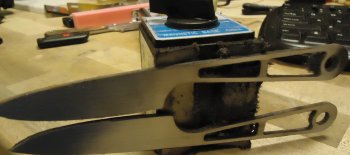J. Doyle
Dealer - Purveyor
....for newer makers or those wanting to start out in knifemaking.
This is not pointed at anyone in particular but rather a seemingly large group of people in general based on my personal experiences/various readings on the forums and similar experiences of some of my peers.
These two points cause people more headache and grief than almost any other issues I can think of. They are a MUST to understand if you want to be successful as a knifemaker, whether full time or hobby maker.
1: Learn how to make stuff FLAT and STRAIGHT!!! I don't care what material or stage in the process you are working on, you will need to make it flat and/or straight in some way. Don't expect that others should provide you materials already in this state or that it will stay that way if they do. Learn to do this yourself or you will most likely struggle as a knifemaker.
2: Master the basic fundamentals of making a knife before moving on to more complex methods and embellishments. I can't begin to count all the times I see someone attempt complicated build methods and fancy embellishments and they don't have a clue as to nice proportions, good flow, pleasing lines, clean grinds and well done finishes. If you don't have a decent handle on those things, no amount of Damascus, filework, hamon or exotic materials is going to mean much of anything. Get a good grasp of the basics THEN move on to the other stuff.
That is all.
This is not pointed at anyone in particular but rather a seemingly large group of people in general based on my personal experiences/various readings on the forums and similar experiences of some of my peers.
These two points cause people more headache and grief than almost any other issues I can think of. They are a MUST to understand if you want to be successful as a knifemaker, whether full time or hobby maker.
1: Learn how to make stuff FLAT and STRAIGHT!!! I don't care what material or stage in the process you are working on, you will need to make it flat and/or straight in some way. Don't expect that others should provide you materials already in this state or that it will stay that way if they do. Learn to do this yourself or you will most likely struggle as a knifemaker.
2: Master the basic fundamentals of making a knife before moving on to more complex methods and embellishments. I can't begin to count all the times I see someone attempt complicated build methods and fancy embellishments and they don't have a clue as to nice proportions, good flow, pleasing lines, clean grinds and well done finishes. If you don't have a decent handle on those things, no amount of Damascus, filework, hamon or exotic materials is going to mean much of anything. Get a good grasp of the basics THEN move on to the other stuff.
That is all.


